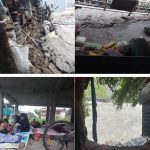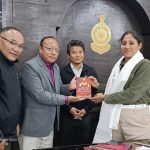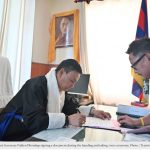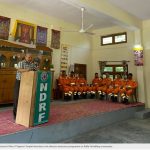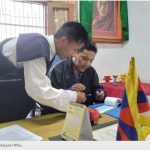Dharamshala: “The Chinese government officials who think they can get away with violating Tibetan rights, that they can act with impunity are proved wrong now. The US government is taking actions and all those Chinese officials, hopefully, even their family members will be put under restrictions if they want to visit the US,” said President Dr Lobsang Sangay.
Speaking to the Republic TV’s Editor Niranjan this morning, President Dr Lobsang Sangay welcomed the US govt’s latest sanctions imposed on PRC government and Chinese Communist Party officials under the Reciprocal Access to Tibet Act.
“This is the right message that the US government is sending,” he said.
The US Secretary of State has on Tuesday announced to implement the Reciprocal Access to Tibet Act and impose visa restrictions on PRC government and Chinese Communist Party officials found to have restricted journalists, tourists, diplomats or other US officials from entering autonomous regions in Tibet.
Dr Sangay said there is a growing consensus in the international community that they ought to make China accountable for all the human rights violations taking place in China in general and in Tibet, in particular, as well as in Xinjiang and Inner Mongolia and so on.
“The international community is coming together on the issue of Tibet,” he said as he mentioned the recent EU-China summit where the EU raised the issue of human rights violations of Tibetan people.
“In addition, at the UN, 50 human rights experts have issued open statements stating their desire to visit China and Tibet to investigate the human rights violations committed on Tibetans.”
Noting that “all forces are on the Tibetan side, especially India and the US”, Republic TV’s Niranjan observed that it was “no coincidence” that the US imposed visa restrictions as it was in line with the US govt’s long held stand on Tibet.
President Dr Sangay agreed, saying that the US has always stood with the people of Tibet and its latest policy has re-affirmed its bipartisan consensus on the issue of Tibet.
The editor then asked about the growing momentum of the Tibetan movement around the world, especially in India.
“In the last few days, here at Republic TV newsrooms, we have been picking up so many visual sequences, incidents of Tibetans protesting against China outside the Chinese embassy in different countries; we had visuals from Toronto,” the editor noted. “Just this morning we had another update coming in of the US acting against China, especially on the access to Tibet, curbing down on visas for the Communist Party of China and the People’s Republic of China. Around the world and especially in India, there seems to be a big focus on Tibet and the fight to ensure that, they are not just India, but even the US stands firmly behind the Tibetan movement.”
Commenting on the protests, President Dr Sangay said it is a natural reaction for Tibetans to come out in support of the people and government of Tibet.
He said the protest demonstrates Tibetan’s solidarity with India amidst the Chinese border incursions.
“It’s a natural reaction of Tibetans whether in the US, New York or Toronto. Wherever they can, they could come out showing solidarity with India, as His Holiness calls himself, ‘Proud son of India’ so Tibetans in exile feel the same towards India for its generosity, for its support, so we feel the pain and we show our solidarity,” Dr Sangay said.
Coming to “the core issue of Tibet”, Niranjan asked the Tibetan President whether it should be prioritized in diplomatic relations with China, “the narrative vis-à-vis China, diplomatically”.
“China regards Tibet among its core issues, so should India,” replied President Dr Sangay, especially considering “the geopolitical, historical, cultural, spiritual relationships” between India and Tibet.
He also argued that when media channels refer to the border as Indo-China border, that itself “opens up the door for China’s justification for their presence at the border and their transgressions and legitimizes the occupation of Tibet”.
Instead, he suggested calling it a “Indo-Tibet border” as it rightfully is. Never in history has India and China never shared a border. India only shared the border with Tibet, that too the most peaceful, conflict-free border in the whole world.
Dr Sangay said that Tibet was in fact a Zone of Peace which served as a historical buffer between India and China for centuries. He said it is no longer the case since the invasion of Tibet, and hence all the recent border tensions.
He stressed that news media and intellectuals should consciously start referring to the border as Indo-Tibet border in light of the historical and geo-political significance and those in areas of studying the map of Tibet, “should include the whole of Tibet, not China-drawn map.”
Calling the Tibet issue as core to the border conflict, he reiterated that until you solve the issue of Tibet, the border incursion and all these prevailing tensions will remain.
The President said His Holiness the Dalai Lama’s Middle Way Approach policy which proposes to make Tibet a demilitarized zone is the most viable solution to the issue. If Tibet is demilitarized, there won’t be any issues over the border as we have been seeing recently.
Responding to the final question on how the Tibetan community perceive the recent face off at Ladakh, Dr Sangay said, “Tibet has been expecting it and have been saying it for the last 60 years.”
Like a dejavu, he said this is exactly how China occupied Tibet in 1959 in the guise of building roads, infrastructure and “prosperity”.
He therefore suggested that taking heed of the Tibet narrative can help contextualize China’s military aggression and infrastructure built up along the LAC.
“We have been saying for the last 60 years that what happened to Tibet could happen to all neighbouring countries, including India, and now it is already happening.”




